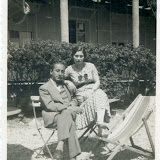The mystery of a married couple’s snapshots
“The past is never dead, it is not even past.”
William Faulkner.
The photographs in this post are a perfect example of the paradox of using photography as social history, namely, the more evidence accumulated the more uncertain the proof. Originally it was three images taken at the Paris Colonial Exposition in 1931 that caught my eye, and then a few more showing the same couple in the box. Over the following months more turned up in other shops across Istanbul so it became a project accumulating as many as possible with the idea I was building up a picture of a marriage. But as photos emerged so did more questions, none with any answers. One photo showed the woman holding hands with a child about four or five. Was it hers? If so, why hadn’t he or she appeared in earlier photos? This wasn’t a case of discovering a skeleton in the closet so much as a jumble of bones in a museum’s crate and realizing some long departed curator had mislabelled them.
Why the photos turned up in so many shops was another of the mysteries. Clearly, they hadn’t been sold to one dealer as part of an estate. Possibly a descendant had unloaded them on the shops but it’s doubtful anyone would go to the effort of visiting so many stores and negotiating for what would have been a few lira at most. More likely they fell into the hands of an itinerant junk dealer who tried to get what he could.
There are now somewhere in the vicinity of a hundred photographs of this couple in the archive, and as the gallery indicates, there are ID, photo-booth and studio portraits mixed up with the snapshots. One small, intact album has photos of a man who is clearly the brother of the husband, and his wife living in Germany. The backs of the photos are stamped Frankenthal. Like the couple they were obviously well off and cultured. There are almost no handwritten notes on the backs of the photographs though a few have Ottoman script, suggesting they were Turkish citizens. Or at least the man was. There are a few of the woman with another woman who could be her mother and they appear to have been taken in France. It’s just a hunch but when I say they are Turkish citizens I mean they may be Armenians. It fits with the diaspora; a lot of Armenians left Turkey for Europe, then again there are a lot of hunches in this story.
It is obvious from the photographs that theirs was a happy marriage. The first photo in the gallery shows the two of them sitting in a garden. You will note that though they sit together she occupies a higher position. This may be a small point but in Turkish photos from the era it is more common for the man to stand behind and appear taller. In this shot there doesn’t appear to be any issues of ownership or dominance. Another detail is that the marriage is documented over at least a couple of decades. We watch the couple ageing together. The variety of types of photographs is also a good sign. They didn’t just take pictures of each other; they collected them.
Obviously (and speaking as a collector, this is a bit of a shame really) most people don’t make a point of recording the low points and moments of tension that are part of a marriage. What we get from any album is such a selective account it is almost fictional, in the sense anyway that we understand we are getting a highly edited version. Were we to take photo albums as any authoritative evidence of peoples’ lives we would be left with the conclusion that existence is a happy, quiet thing, a bit like a cat sleeping in the corner.
At a point about the couple’s late forties the photos stop. It’s natural to speculate on the worst – death, divorce – but this is a common situation. There comes a stage when people step back from documenting their lives and the job falls to a son or daughter who are staring their own family and beginning the process again. Maybe it also has something to do with vanity; after a certain point what we are recording now is ourselves growing older. Perhaps the marriage reaches a plateau where we no longer need any evidence to substantiate it. That though implies that the act of photographing is a kind of neurosis where we can’t rely on memory alone as proof that something actually happened, an idea most of us would naturally resist.
If these photos had been found intact in one album I would have considered them interesting though not necessarily special. That they were scattered about the city gives them their poignancy. At some point the record of two people’s love and marriage fell into the hands of somebody else for whom they were merely a bunch of old photos. Their dispersal became as effective an annihilation as tipping them into an incinerator. This raises another issue. By collecting the photos I was in effect perpetuating the memory of a marriage that meant nothing to me but in its way became important. Is that what we do when we collect old albums? Do we feel we have some responsibility to the dead?
 |
| SCENES FROM A MARRIAGE |







No comments:
Post a Comment
Add comments here